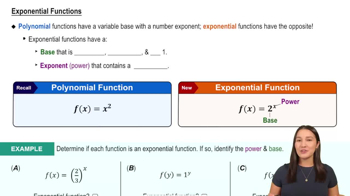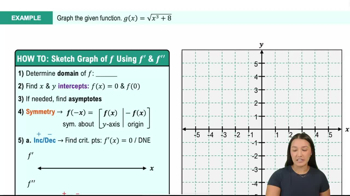Table of contents
- 0. Functions7h 52m
- Introduction to Functions16m
- Piecewise Functions10m
- Properties of Functions9m
- Common Functions1h 8m
- Transformations5m
- Combining Functions27m
- Exponent rules32m
- Exponential Functions28m
- Logarithmic Functions24m
- Properties of Logarithms34m
- Exponential & Logarithmic Equations35m
- Introduction to Trigonometric Functions38m
- Graphs of Trigonometric Functions44m
- Trigonometric Identities47m
- Inverse Trigonometric Functions48m
- 1. Limits and Continuity2h 2m
- 2. Intro to Derivatives1h 33m
- 3. Techniques of Differentiation3h 18m
- 4. Applications of Derivatives2h 38m
- 5. Graphical Applications of Derivatives6h 2m
- 6. Derivatives of Inverse, Exponential, & Logarithmic Functions2h 37m
- 7. Antiderivatives & Indefinite Integrals1h 26m
- 8. Definite Integrals4h 44m
- 9. Graphical Applications of Integrals2h 27m
- 10. Physics Applications of Integrals 2h 22m
5. Graphical Applications of Derivatives
Curve Sketching
Problem 4.R.118c
Textbook Question
{Use of Tech} A family of superexponential functions Let ƒ(x) = (a + x)ˣ , where a > 0.
c. Compute ƒ'. Then graphƒ and ƒ' for a = 0.5, 1, 2, and 3.
 Verified step by step guidance
Verified step by step guidance1
To find the derivative ƒ'(x) of the function ƒ(x) = (a + x)^x, we will use logarithmic differentiation. Start by taking the natural logarithm of both sides: ln(ƒ(x)) = ln((a + x)^x).
Apply the logarithmic identity ln((a + x)^x) = x * ln(a + x). This simplifies the expression to ln(ƒ(x)) = x * ln(a + x).
Differentiate both sides with respect to x. For the left side, use the chain rule: d/dx[ln(ƒ(x))] = ƒ'(x)/ƒ(x). For the right side, use the product rule: d/dx[x * ln(a + x)] = 1 * ln(a + x) + x * (1/(a + x)).
Combine the derivatives: ƒ'(x)/ƒ(x) = ln(a + x) + x/(a + x). Solve for ƒ'(x) by multiplying both sides by ƒ(x): ƒ'(x) = ƒ(x) * (ln(a + x) + x/(a + x)).
Substitute ƒ(x) = (a + x)^x back into the expression for ƒ'(x): ƒ'(x) = (a + x)^x * (ln(a + x) + x/(a + x)). Now, you can graph ƒ(x) and ƒ'(x) for the given values of a: 0.5, 1, 2, and 3.
 Verified video answer for a similar problem:
Verified video answer for a similar problem:This video solution was recommended by our tutors as helpful for the problem above
Video duration:
4mPlay a video:
Was this helpful?
Key Concepts
Here are the essential concepts you must grasp in order to answer the question correctly.
Differentiation
Differentiation is a fundamental concept in calculus that involves finding the derivative of a function. The derivative represents the rate of change of the function with respect to its variable. For the function ƒ(x) = (a + x)ˣ, applying the rules of differentiation, particularly the product and chain rules, is essential to compute ƒ'.
Recommended video:

Finding Differentials
Exponential Functions
Exponential functions are mathematical functions of the form f(x) = a^x, where 'a' is a constant and 'x' is the variable. In the given function ƒ(x) = (a + x)ˣ, the base of the exponent is not constant, which introduces complexity in its behavior. Understanding the properties of exponential growth and how they affect the graph is crucial for analyzing ƒ and its derivative.
Recommended video:

Exponential Functions
Graphing Functions
Graphing functions involves plotting the values of a function and its derivative on a coordinate plane to visualize their behavior. For the function ƒ(x) and its derivative ƒ', it is important to consider how changes in the parameter 'a' affect the shape and position of the graphs. This visual representation aids in understanding the relationship between the function and its rate of change.
Recommended video:

Graph of Sine and Cosine Function

 11:41m
11:41mWatch next
Master Summary of Curve Sketching with a bite sized video explanation from Callie
Start learning




